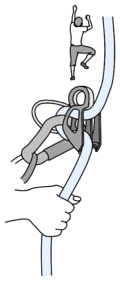Tuber (Tubular belay device): Difference between revisions
| Line 11: | Line 11: | ||
Tubular belay devices are the most commonly used belay devices during training of advanced climbing and rescue techniques, multipitching and management of twin/double ropes. In some countries/clubs, they have been replaced by assisted tubular belay devices for single-pitch training. They are prohibited in some gyms due to alleged security concerns (for details, see the security concerns section). | Tubular belay devices are the most commonly used belay devices during training of advanced climbing and rescue techniques, multipitching and management of twin/double ropes. In some countries/clubs, they have been replaced by assisted tubular belay devices for single-pitch training. They are prohibited in some gyms due to alleged security concerns (for details, see the security concerns section). | ||
== | == Belaying risks == | ||
Do a partner check of the device and its handling before each climb. Always hold/control the break strand at least with one hand. Tunneling is considered completely secure and it is the recommended technique in some of the alpine clubs. During tunneling, one should not fully open the hand (keeping at least the thumb and index finger in touch for the whole time) and the rope should slide on the rope. If the rope starts to slide, the hand can reflexively grab the rope. Letting the break strand loose is perceived as the main cause of accidents and injuries (for details/discussion, see the security concerns section). Keep your hand at least a few centimeters from the belay device to avoid pinching of the skin on your index finger if the rope slips a bit. Non-assisted tubular belay devices brakes the best if the rope is pointed downwards. Rule of a thumb is not to go above the line of a device while giving the slack and keeping the hand downwards during the resting state. One of the commonly seen bad habit is keeping the hand raised for a prolonged amount of time during belaying. Practicing and good habit building is crucial. If belaying after a pause in climbing, it is strongly recommended to get accustomed to the belay again and practice it for a while in a safe setting. | Do a partner check of the device and its handling before each climb. Always hold/control the break strand at least with one hand. Tunneling is considered completely secure and it is the recommended technique in some of the alpine clubs. During tunneling, one should not fully open the hand (keeping at least the thumb and index finger in touch for the whole time) and the rope should slide on the rope. If the rope starts to slide, the hand can reflexively grab the rope. Letting the break strand loose is perceived as the main cause of accidents and injuries (for details/discussion, see the security concerns section). Keep your hand at least a few centimeters from the belay device to avoid pinching of the skin on your index finger if the rope slips a bit. Non-assisted tubular belay devices brakes the best if the rope is pointed downwards. Rule of a thumb is not to go above the line of a device while giving the slack and keeping the hand downwards during the resting state. One of the commonly seen bad habit is keeping the hand raised for a prolonged amount of time during belaying. Practicing and good habit building is crucial. If belaying after a pause in climbing, it is strongly recommended to get accustomed to the belay again and practice it for a while in a safe setting. | ||
TODO: Gallery | {{#invoke:FlexGallery|gallery_with_widths | ||
|File:tuber_blocked.png | |||
|120px | |||
|Always hold the break strand downwards unless feeding the rope | |||
|File:tuber_warn_closehand.png | |||
|130px | |||
|If the break hand is too close, belayer risks pinching of the skin of the index finger. | |||
}} | |||
TODO: Gallery - nohand | |||
</translate> | </translate> | ||
Revision as of 05:13, 24 August 2025
Tubular belay devices are the most commonly used belay devices during training of advanced climbing and rescue techniques, multipitching and management of twin/double ropes. In some countries/clubs, they have been replaced by assisted tubular belay devices for single-pitch training. They are prohibited in some gyms due to alleged security concerns (for details, see the security concerns section).
Belaying risks
Do a partner check of the device and its handling before each climb. Always hold/control the break strand at least with one hand. Tunneling is considered completely secure and it is the recommended technique in some of the alpine clubs. During tunneling, one should not fully open the hand (keeping at least the thumb and index finger in touch for the whole time) and the rope should slide on the rope. If the rope starts to slide, the hand can reflexively grab the rope. Letting the break strand loose is perceived as the main cause of accidents and injuries (for details/discussion, see the security concerns section). Keep your hand at least a few centimeters from the belay device to avoid pinching of the skin on your index finger if the rope slips a bit. Non-assisted tubular belay devices brakes the best if the rope is pointed downwards. Rule of a thumb is not to go above the line of a device while giving the slack and keeping the hand downwards during the resting state. One of the commonly seen bad habit is keeping the hand raised for a prolonged amount of time during belaying. Practicing and good habit building is crucial. If belaying after a pause in climbing, it is strongly recommended to get accustomed to the belay again and practice it for a while in a safe setting.
TODO: Gallery - nohand


